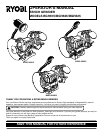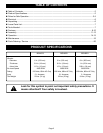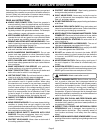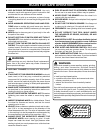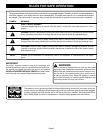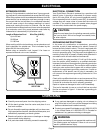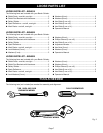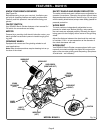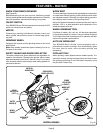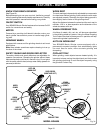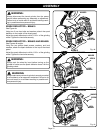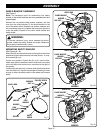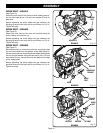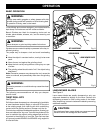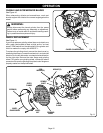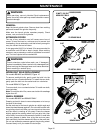
Page 3
RULES FOR SAFE OPERATION
Safe operation of this power tool requires that you read and
understand this operator's manual and all labels affixed to
the tool. Safety is a combination of common sense, staying
alert, and knowing how your bench grinder works.
READ ALL INSTRUCTIONS
n KNOW YOUR POWER TOOL. Read the operator's
manual carefully. Learn the applications and limitations
as well as specific potential hazards related to this tool.
n GUARD AGAINST ELECTRICAL SHOCK by prevent-
ing body contact with grounded surfaces. For example:
pipes, radiators, ranges, refrigerator enclosures.
n KEEP GUARDS IN PLACE and in working order. Never
operate the tool with any guard or cover removed. Make
sure all guards are operating properly before each use.
n REMOVE ADJUSTING KEYS AND WRENCHES. Form
habit of checking to see keys and adjusting wrenches are
removed from tool before turning it on.
n KEEP THE WORK AREA CLEAN. Cluttered work areas
and work benches invite accidents.
n AVOID DANGEROUS ENVIRONMENTS. Do not use
power tools near gasoline or other flammable liquids,
in damp or wet locations or expose them to rain. Keep
work area well lighted.
n KEEP CHILDREN AND VISITORS AWAY. All visitors
should wear safety glasses and be kept a safe distance
from work area.
n MAKE WORKSHOP CHILDPROOF with padlocks,
master switches, or by removing starter keys.
n DON’T FORCE THE TOOL. It will do the job better and
safer at the rate for which it was designed.
n USE THE RIGHT TOOL. Do not force the tool or attach-
ment to do a job for which it was not designed.
n USE THE PROPER EXTENSION CORD. Make sure
your extension cord is in good condition. When using
an extension cord, be sure to use one heavy enough to
carry the current your product will draw. An undersized
cord will cause a drop in line voltage resulting in loss of
power and overheating. A wire gage size (A.W.G.) of at
least 16 is recommended for an extension cord 25 feet
or less in length. If in doubt, use the next heavier gage.
The smaller the gage number, the heavier the cord.
n INSPECT EXTENSION CORDS PERIODICALLY and
replace if damaged.
n WEAR PROPER APPAREL. Do not wear loose clothing,
neckties, or jewelry that can get caught in the tool’s
moving parts and cause personal injury. Nonslip footwear
is recommended when working outdoors. Wear protective
hair covering to contain long hair.
n ALWAYS WEAR SAFETY GLASSES WITH SIDE
SHIELDS. Everyday eyeglasses have only impact-
resistant lenses; they are NOT safety glasses.
n PROTECT YOUR LUNGS. Wear a face or dust mask if
the cutting operation is dusty.
n PROTECT YOUR HEARING. Wear hearing protection
during extended periods of operation.
n DON’T ABUSE CORD. Never carry tool by the cord or
yank it to disconnect from receptacle. Keep cord from
heat, oil, and sharp edges.
n DO NOT OVERREACH. Keep proper footing and balance
at all times.
n MAINTAIN TOOLS WITH CARE. Keep tools sharp and
clean for best and safest performance. Follow instructions
for lubricating and changing accessories.
n NEVER LEAVE TOOL RUNNING UNATTENDED. TURN
POWER OFF. Disconnect all tools when not in use, before
servicing, or when changing attachments, wheels, etc.
n AVOID ACCIDENTAL STARTING. Be sure switch is off
when plugging in.
n USE RECOMMENDED ACCESSORIES. The use of
improper accessories may cause risk of injury.
n USE ONLY GRINDING WHEELS that comply with ANSI
B7.1 and rated greater than 3600 RPM.
n DO NOT use wheels with incorrect size holes. NEVER
use wheel washers or wheel screws that are defective
or incorrect and NEVER touch grinding wheel or other
moving parts.
n NEVER STAND ON TOOL. Serious injury could occur if
the tool is tipped or if the wheel is unintentionally con-
tacted.
n DIRECTION OF FEED. Be aware of wheel rotation direc-
tion; never grind without the workrest being properly set.
NEVER grind more than one workpiece at a time.
WARNING: Wheel coasts after turn off.
n CHECK DAMAGED PARTS. Before further use of the
tool, a guard or other part that is damaged should be
carefully checked to determine that it will operate properly
and perform its intended function. Check for alignment
of moving parts, binding of moving parts, breakage of
parts, mounting and any other conditions that may affect
its operation. A guard or other part that is damaged must
be properly repaired or replaced by an authorized service
center to avoid risk of personal injury.
n KEEP TOOL DRY, CLEAN, AND FREE FROM OIL AND
GREASE. Always use a clean cloth when cleaning. Never
use brake fluids, gasoline, petroleum-based products, or
any solvents to clean tool.
n INSPECT TOOL CORDS AND EXTENSION CORDS
PERIODICALLY and, if damaged, have repaired by a
qualified service technician. Stay constantly aware of
cord location and keep it well away from the rotating
wheel.
n NEVER USE IN AN EXPLOSIVE ATMOSPHERE. Normal
sparking of the motor or sparking from grinding metal could
ignite fumes.



